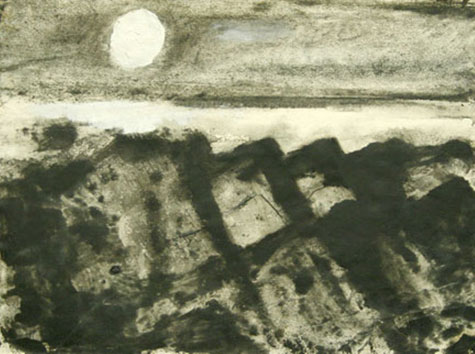
"OUTER SHORE" Ink and gouache on paper, by William Thon, 1992. |
In the current show at the June Fitzpatrick Gallery at the Maine College of Art in Portland, we see two generations of 20th-century modernist painting.
Carl Gordon Cutler was a well-known Boston artist, one of the "Boston Four" painters with Maurice Prendergast, E. Ambrose Webster, and Charles H. Pepper, who blended their French training with modernist ideas to bring a new flavor to American painting. Cutler died in 1945 at the age of 72.
William Thon's paintings were informed by cubism, fracturing the landscape into planes of color with a distinct rhythm that gave his pictures a tangible presence. Thon died in 2000 at the age of 94.
Both artists made Maine a central part their work. Cutler would come to Maine every year, especially to Eggemoggin Reach, where he had a cottage. Thon moved to Port Clyde in 1940 and lived there full-time for the rest of his life. They both painted in other media, but this show is entirely of works on paper: watercolors by Cutler and ink and gouache by Thon.
Cutler was an ardent colorist who wrote an instruction book about how to use color in painting. Thon also used color in paintings but the works in this show, done late in his career, are all black and white.
Cutler wrote about using color relationships to build a realistic sense of how things look. He built his paintings up from small strokes, sometimes using counterintuitive local relationships to produce his effects. In "Gathering Clouds" you can see how this works. The layout is a pretty conventional Maine landscape — the foreground is anchored by shrubs and a small tree, a low hill occupies middle ground, and distant water and hills form the horizon. The titular clouds fill the top half of the picture, little circular bursts of white with strokes of blue showing through.
Everything sits where it's supposed to — the distant hills seem far away, the bushes seem close. The hill is colored by the dappled sunlight and shadow from the partly cloudy sky. There's not much detail, just small colored areas, and when you parse one color out from its neighbors, it seems unreal, even odd. Yet together they form a convincing picture.
Toward the end of his life Bill Thon was legally blind. Macular degeneration had robbed him of detail and color. Instead of giving up, he found a way to keep working using gouache, water, and ink on paper that rested on a board he could move around to get the water running where he wanted it to go. He would get a piece started, then pin it up and stand back from it so he could see it with a little monocular he carried.
He made a lot of work in those years, work that was vital, effective, and wholly convincing. He worked with the few visual means that were still available to him, just black lines, lights, and darks. Many of us thought at the time, and still think, it was some of the best work he had done in years.